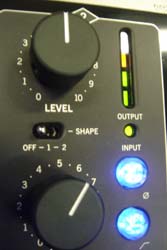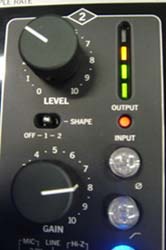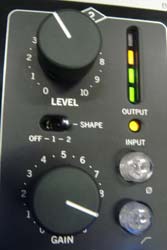Volume 3, Number 3, May 2005
[UA Universe] [Ask the Doctors] [Digital Minds] [Analog Obsession]
[Support Report] [The Channel] [Plug-In Power] [Analog Ears] [Featured Promotion]
[Graphic-Rich WebZine]
[Back Issues] [UA Home]
Dialing in UA's New Precision Preamp
By Will Shanks
 |
|
|
Design Primer
The design goals of the Precision Preamp were all aimed at sound quality and recording functionality first--cost second. UA set out to create a brand-new type of preamp that would satisfy these requirements: to be a tonally versatile, Class-A unit with a wide spectrum of useful sounds to handle multichannel applications; to hold its own with the best modern, ultra-clean units, but have enough variation in sonics for those wish to add "character"; to offer substantial gain and headroom, plus impedance options to handle the most diverse mic cupboards; to remain true to the heritage and musicality standards set by UA's preceding products. After nearly two years of design and implementation, the Precision Preamp meets these goals and truly gives the user a new experience in quality and versatility from a multichannel unit. (Further discussions with the design engineers of the Precision can be found in the December 2004 UA Webzine.)
Features and Topology
The Precision is a Class A circuit design with lightning-fast transients, high headroom, ultra-low noise, and 74 dB of gain. The signal path design is direct -coupled with all-discrete components, including input transformers; there are no capacitors in the audio path. Every channel of the 8110 Precision and 4110 Precision features dedicated Gain and Level controls, input and output metering, dual-input impedance selection, and a three-way "Shape" switch, which offers a variable signal-path for maximum sonic versatility. Also included are Polarity, Phantom, Low Cut (100 Hz at 6 dB per octave), Pad (15 dB) and 48+ Phantom Power. The only difference between the 8110 and 4110 is the 4110 adds four front panel Hi-z inputs.
A Shapely Shape
As stated above, Universal Audio's goal for the Precision preamps was to offer multichannel units that achieve a wide range of tonality, which is rare in most multichannel mic pre's. As the Precision begins hitting the street, many new users and UA fans are asking about the Shape feature. Along with the tone-shaping options found on all UA products, like Gain/Level controls and multiple impedance settings, the Shape switch is your gateway to the ultimate in tonal variety.
The Shape switch allows for three unique topology states within each channel of the Precision; we've adopted the terms (Off) Modern, (1) Vintage and (2) Saturate.
 |
(Off) Modern This position selects the purest signal path. It will give the most transparent results, yielding "straight-wire" characteristics--clean, clear, full bandwidth and distortion-free. Use this setting when it is crucial that you achieve the utmost in transparency, fidelity and frequency response. |
|
Typical Modern mode gain staging.
|
|
 |
(1) Vintage This position selects transformer loading. This setting changes the loading on the mic/line input transformer to provide more of that "iron" sound popular in vintage transformer-coupled preamps. This could be described as warmer and more present, with more sensitivity to the microphone's impedance curve--a bit of harmonic coloration, enhancing mid-frequency tone and presence, or a more three-dimensional character. The secret in dialing how much transformer character you want is in the Gain control--the greater the gain, the greater the coloration. |
| Vintage mode yields more character when the gain is hit hard. | |
 |
(2) Saturate This position is the same as Position 2, with the addition of a soft limiting circuit. This setting uses the same transformer loading as Position 1, but also adds more loading to the first-stage preamp, which changes its phase response and bias points, making it perfect for smoothing out transients without clipping. When you are using this position, the input signal is naturally lowered and high frequencies are attenuated. Again, experiment with higher Gain settings to achieve greater "saturation." |
| Saturate mode also yields greater character and limiting when hit hard. |
The following sound examples present electric guitar, bass, and multitracked drumset, all using the Precision. Full mixes, drum mixes, guitar mixes and bass mixes are all available at 96 kHz, 44.1 kHz (WAV) and MP3 format. The tracks were recorded and mixed without any EQ, compression or any other enhancements-just the sound of the microphones and the Precision Preamps.
| 8110 & 4110 Sound Samples | ||||||
| Bass | Drums | Guitar | Mix | For best results, right click (Mac: control click) and use "save target as..." or similar in the pop up menu to save the sound files to your hard drive, then play them from your DAW application. | ||
|
Modern
|
.mp3 .wav |
.wav .mp3 |
.wav .mp3 |
96k .wav .mp3 |
||
|
Vintage
|
.wav .mp3 |
.wav .mp3 |
.wav .mp3 |
96k .mp3 .wav |
||
|
Saturate
|
.wav .mp3 |
.wav .mp3 |
.wav .mp3 |
96k ,mp3 .wav |
||
| .mp3s are 192 kbps. .wav files are 24 bit 44.1k except where noted as "96k". |
||||||
E-mail me privately if you really want to know what mics were used, or have any other questions about the setup. Please excuse the marginal kick sound; I was on bass!